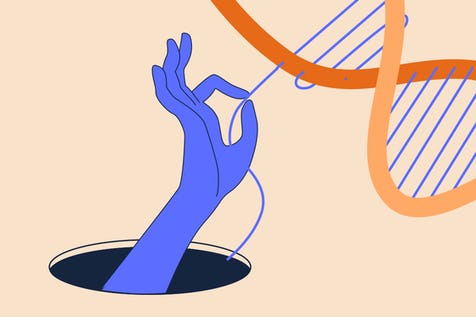What orchestrates the events that happen behind the scenes during each cycle? What determines when a mature egg is released or triggers the thickening of your uterine lining?
Well, the invisible force that shapes how your body behaves and responds is none other than your hormones. And yes, hormones play an equally important role in your reproductive system as they do in other parts of your body.
These key players work tirelessly behind the scenes to maintain the rhythm of your menstrual cycle and make natural processes happen—including pregnancy. They're also responsible for sending signals to the uterus that go along the lines of, "Hey, it's that time of the month again!"
Because hormones play such a crucial role in your fertility, you may be keen to deepen your understanding of their different functions in your body. Knowing your hormones gives you a clearer idea of what each fluctuation and change means for your body.
What Are Hormones?
Hormones are chemical messengers. There three main classes of hormones include [1]:
- Lipid-derived hormones. These include steroid hormones made of cholesterol.
- Amino acid-derived hormones. (Amino acids are the basic building blocks of protein).
- Peptide hormones. These are made from small chains of amino acids.
Different organs and tissues in your body synthesise these hormones, which are then secreted into your blood and carried to other parts of your body.
Upon reaching the target site, the hormone will bind to a receptor and deliver a message that signals the organ or tissue to carry out a specific action. Hormones allow one part of your body to communicate with another, quite like a messenger pigeon before the telephone was invented.
What Are Sex Hormones?
Sex hormones are hormones that play a role in reproduction, fertility, and sexual development. From regulating the growth of your muscles and bones to maintaining sexual libido and promoting hair growth—sex hormones are crucial for facilitating a range of bodily processes and maintaining your general health.
Steroid sex hormones present in females include:
- Estrogen
- Progesterone
- Testosterone (male sex hormones) in small amounts.
What pops into your head at the mention of testosterone? Unsurprisingly, some of us might conjure up thoughts of big-muscled men. While testosterone is a male sex hormone commonly linked to muscle growth, women naturally produce small amounts of testosterone as well.
Testosterone plays a role in regulating your sex drive, bone health, fertility, and maintaining muscle mass—in other words, testosterone is an essential hormone for females, too [2].
Estrogen and progesterone are female sex hormones that are also important when it comes to your menstrual cycle and pregnancy. We'll explore these hormones further down the article.
So, where are these sex hormones produced?
Well, these steroid sex hormones are primarily produced in your ovaries, but the adrenal glands and fat tissues also produce smaller amounts.
The levels of each hormone will also fluctuate throughout your lifetime and can be affected by a range of factors, including:
- Menstruation
- Menopause
- Pregnancy
- Medical treatment
- Age
- Stress and mood [3]
Other than the steroid hormones progesterone and estrogen, the follicle-stimulating hormone (FSH) and luteinizing hormone (LH) are two other hormones heavily involved in your menstrual cycle [4]. These can be considered female sex hormones, but they're not steroid hormones.
Your Menstrual Cycle and Hormones
Let's explore the menstrual cycle and the key hormones involved in each phase.
Your menstrual cycle is divided into four main phases, the menstrual, follicular, ovulation, and luteal phase.
Menstrual phase
The menstrual phase begins on the first day of your period. If you don't get pregnant, the levels of progesterone and estrogen in your body drop, and this leads to an event called menstruation.
During menstruation, your uterus sheds its lining to release a combination of blood, mucus, and tissues through the vagina.
The drop in progesterone levels causes the constriction of the spiral arteries—which are small arteries that temporarily supply blood to the lining of your uterus during the luteal (final) stage of your menstrual cycle [4].
Because of this, there is a decreased supply of blood to the outermost, superficial layer of your uterine lining. These tissues begin to degenerate, and the contraction of your uterus begins to expel them, along with blood and mucus [4].
Key players: A drop in estrogen and progesterone
Follicular phase
The follicular phase begins on the first day of your menstruation, too. So, there is an overlap between the follicular phase and menstrual phase of your cycle.
Your ovaries have many egg-containing pods called primordial follicles, and an immature egg is snuggled within each follicle.
During the follicular phase of each cycle, the follicle-stimulating hormone will stimulate the development of follicles in the ovary. A group of follicles will develop at the same time. However, only the largest and healthiest egg will fully develop. This follicle becomes the dominant follicle, and it contains the mature egg that will be released later during the cycle [5].
At the same time, the developing egg starts to produce estrogen, and the lining of the uterus wall begins to thicken in preparation for possible implantation—which is the attachment of a fertilised egg to the uterus wall. In addition to that, estrogen also increases the secretion of cervical mucus and alters the movement of the fallopian tube to facilitate the entry of an egg into the fallopian tube [6]. The increase in mucus secretion nearing ovulation helps the sperm move through the cervix, so this increase in mucus discharge is typically one symptom of ovulation you can look out for.
Key player: Follicle-stimulating hormone and estrogen
Ovulation
Ovulation refers to the release of the mature egg into your fallopian tube, which are tubes that stretch from your ovaries to your uterus.
Nearing the middle of your cycle, the surge in luteinizing hormone levels begins. This LH surge begins around 35 to 44 hours before ovulation, and it is responsible for initiating ovulation. [7]
On the day of ovulation, the mature egg is finally released from the ovary. This mature egg makes its way down the fallopian tube. It takes its time to travel down the fallopian tube in anticipation of a healthy sperm that has successfully outperformed its competition. If the two meet and fuse, fertilisation occurs.
Some symptoms of ovulation include a change in the texture and colour of your vaginal mucus discharge and a slight rise in body temperature [8].
Because your cycle is unique, knowing when ovulation occurs for you can be very helpful if you're looking to conceive. This is because research has shown that the six most fertile days of your cycle are the five days before ovulation and the day of ovulation itself [10].
Key player: Luteinizing hormone
Luteal phase
The luteal phase usually lasts around 14 days in most women.
After the mature egg bursts from the follicle, that ruptured follicle is now known as a corpus luteum.
During the luteal phase, the corpus luteum will mainly secrete progesterone and smaller amounts of estrogen. These hormones will prime and prepare the uterine lining for implantation, making it more receptive to the attachment of a fertilised egg in the event that fertilisation occurs. [4, 5].
If fertilisation and implantation successfully occur, the corpus luteum maintains the level of progesterone in your body (progesterone is a vital pregnancy hormone). It continues to do so until the placenta secretes enough progesterone to take over this role.
However, if no fertilisation occurs, the corpus luteum shrinks and withers away, causing progesterone and estrogen levels to decrease, leading to the uterus shedding its lining. The cycle then repeats itself.
Key player: Progesterone
Benefits Of Tracking Your Menstrual Cycle
The levels of hormones in your body fluctuate as your body undergoes the different stages of the menstrual cycle. Understanding your menstrual cycle can give you valuable information related to your reproductive health.
Some benefits of tracking your menstrual cycle include the following:
- Learn more about your unique hormonal curve. Only around 16% of women have a standard 28-day cycle [9]. Your menses, fertile window, and day of ovulation will not land on exactly the same day as other women. So, tracking your menstrual cycle allows you to learn more about your own body and cycle.
- Pinpoint your fertile period and day of ovulation. With this information, you'll know when to have sex to boost your chances of conceiving.
- Predict the start of your menses. No one wants to be caught in an emergency without pads. Having a better idea of when your menses is likely to start allows you to prepare beforehand.
- Increase your overall health awareness. Any irregularities in your cycle, such as missed or unpredictable periods, may indicate an underlying condition. Tracking your cycle helps you notice any concerning changes, so you know when to seek advice from your healthcare professional.
There are many apps and devices that enable you to keep track of your menstrual cycle. The inne minilab is one of them. This device helps you track your cycle by measuring the level of progesterone in your body through simple and painless saliva tests.
Your results will then be displayed and interpreted through the inne smartphone app. The information you receive will empower you to learn more about your progesterone curve and find out when you're fertile or going to have your menses.
Ultimately, the minilab offers a convenient and affordable way to track your cycle with lab-grade accuracy!
References
1. Nussey S, Whitehead S. Chapter 1- Endocrinology: An Integrated Approach. In: Principles of endocrinology. 2001. Available from: https://www.ncbi.nlm.nih.gov/books/NBK20/
2. Davis SR, Wahlin-Jacobsen S. Testosterone in women--the clinical significance. Lancet Diabetes Endocrinol. 2015;3(12):980-992. doi:10.1016/S2213-8587(15)00284-3
3. Lei R, Sun Y, Liao J, et al. Sex hormone levels in females of different ages suffering from depression. BMC Womens Health. 2021;21(1):215. Published 2021 May 22. doi:10.1186/s12905-021-01350-0
4. Reed BG, Carr BR. The Normal Menstrual Cycle and the Control of Ovulation. In: Feingold KR, Anawalt B, Boyce A, et al., eds. Endotext. South Dartmouth (MA): MDText.com, Inc.; August 5, 2018.
5. Holesh JE, Bass AN, Lord M. Physiology, Ovulation. In: StatPearls. Treasure Island (FL): StatPearls Publishing; May 9, 2021.
6. Jones RE, Lopez KH. Chapter 3-The Menstrual Cycle. In Human Reproductive Biology (Third Edition). 2006. Available from: https://www.sciencedirect.com/science/article/pii/B978008050836850007X
7. Su HW, Yi YC, Wei TY, Chang TC, Cheng CM. Detection of ovulation, a review of currently available methods. Bioeng Transl Med. 2017;2(3):238-246. Published 2017 May 16. doi:10.1002/btm2.10058
8. Steward K, Raja A. Physiology, Ovulation And Basal Body Temperature. In: StatPearls. Treasure Island (FL): StatPearls Publishing; July 22, 2021.
9. Wilcox AJ, Dunson D, Baird DD. The timing of the "fertile window" in the menstrual cycle: day specific estimates from a prospective study. BMJ. 2000;321(7271):1259-1262. doi:10.1136/bmj.321.7271.1259
10. Grieger JA, Norman RJ. Menstrual Cycle Length and Patterns in a Global Cohort of Women Using a Mobile Phone App: Retrospective Cohort Study. J Med Internet Res. 2020;22(6):e17109. Published 2020 Jun 24. doi:10.2196/17109


.jpg)





